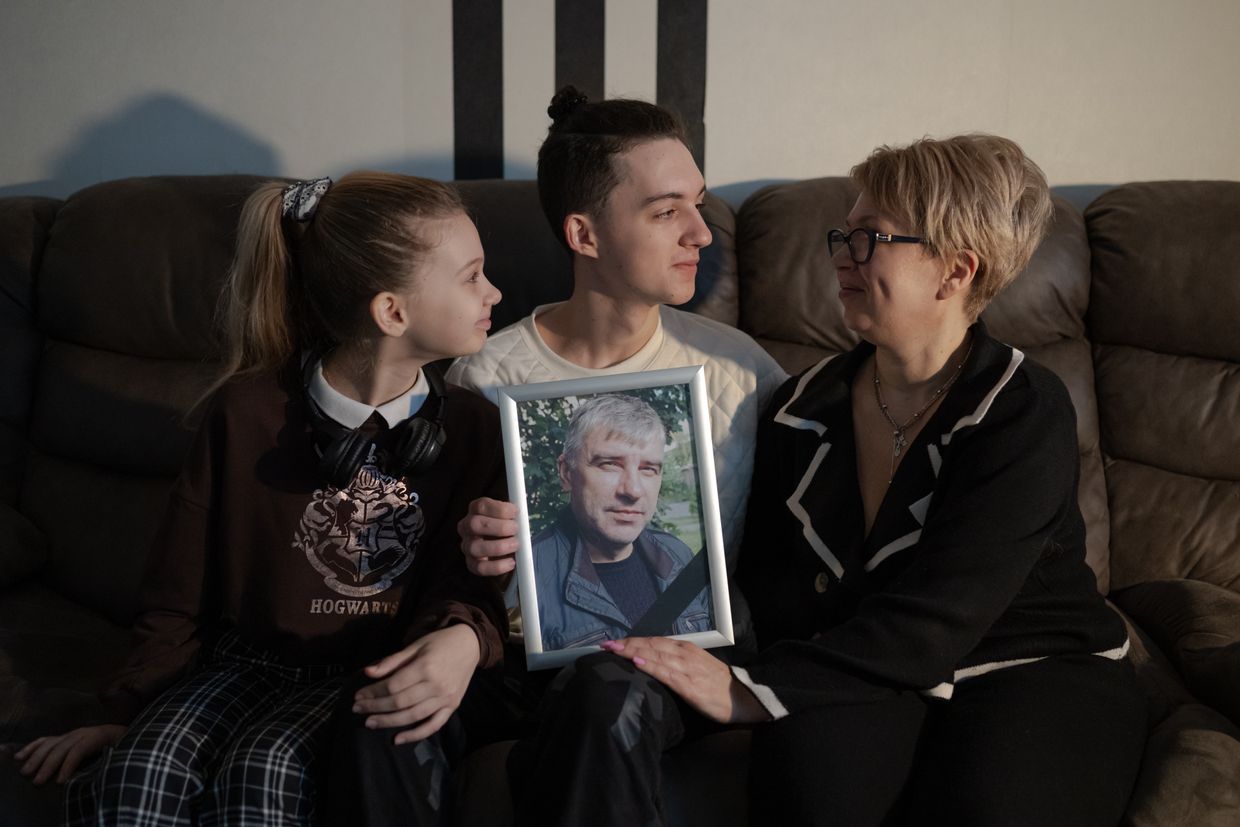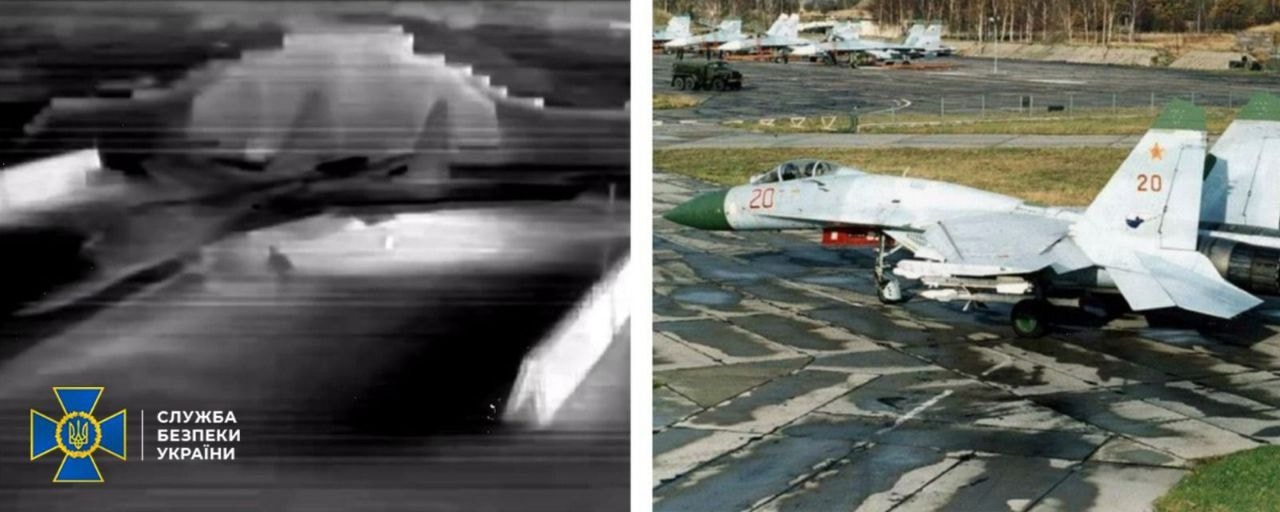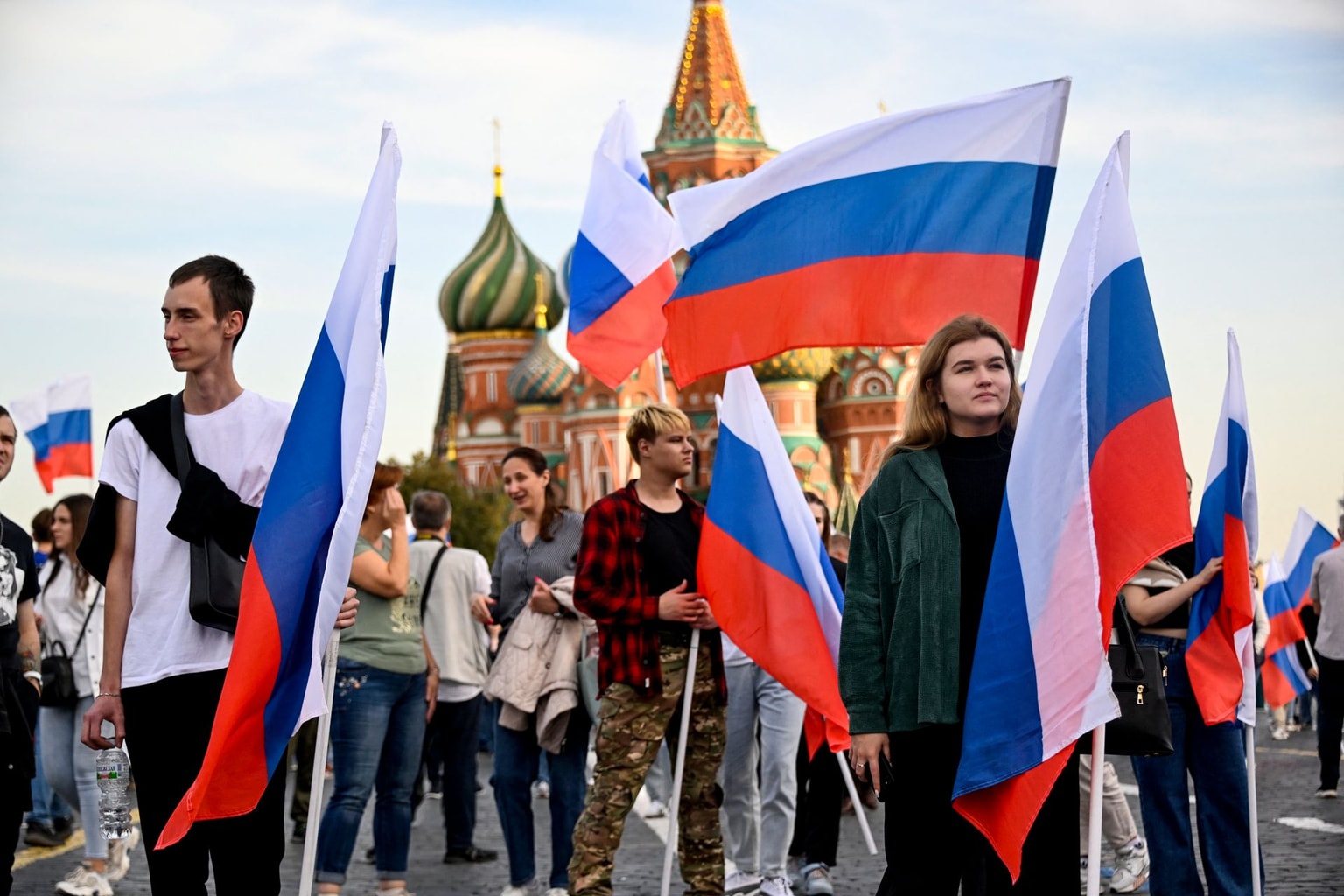
‘Why does everyone have 2 legs but me?’ Children learn to live with prosthetics after being injured by Russia's war
Oleksandr Reshetniak in Ohmatdyt hospital in Kyiv, Ukraine, on March 21, 2024. Eleven-year-old Oleksandr was injured by Russian shelling in Kharkiv Oblast in January 2024, losing part of one leg. As he is recovering, the boy will soon need to learn how to live with prosthetics. (Oleh Tymoshenko / The Kyiv Independent)
Eleven-year-old Oleksandr Reshetniak from Kharkiv Oblast still vividly remembers holding the stump of his torn-off leg, trying to stop the bleeding.
On Jan. 17, Oleksandr and his 13-year-old cousin Alina were heading to a grocery store in his native village of Malyi Burluk, near Kupiansk, in the east of Kharkiv Oblast, to get some after-lunch treats.
Then Russian troops began shelling the area. A shell landed near the children.
Alina suffered severe injuries and died in a coma 10 days later. Oleksandr survived the attack but lost part of his right leg.
Shortly after the attack occurred, Ukrainian soldiers arrived at the site and found the badly wounded children. Oleksandr was still conscious when they found him.
“He received first aid from the military… They applied a tourniquet to his leg, placed him in their vehicle, and without waiting for the ambulance (to arrive), drove to meet it to save time,” the boy’s mother, Natalia Reshetniak, told the Kyiv Independent.

Oleksandr underwent a series of operations in Kharkiv and then more surgery in Kyiv’s Ohmatdyt Children's Hospital, where he was transferred for further treatment and rehabilitation. The boy is now on his way to recovery and will need prosthetics soon.
While horrifying, Oleksandr’s story is far from unique in war-torn Ukraine.
In over two years of Russia’s brutal full-scale invasion, nearly 550 Ukrainian children have been killed, and almost 1,300 wounded, according to the Prosecutor General’s Office.
As of January, at least 30 children had lost limbs due to Russian attacks, says Arman Kacharyan, who heads the innovations division at the Health Ministry’s high-tech medical care department.
The growing number of severe injuries resulting in limb loss due to the Russian full-scale war has increased the demand for pediatric prosthetics in Ukraine – a little-developed field before Feb. 24, 2022 – says Nazar Borozniuk, a physical therapist at the Ohmatdyt hospital.
Unlike adults, children need new prosthetics at least once a year or more often, depending on how fast they grow, which can be quite costly for their families. Children also often struggle psychologically while adjusting to the prosthetics and their new reality.

Starting point
At the age of six, Maryna Ponomarova from Kherson Oblast became the first child to get prosthetics in Ukraine after losing a limb due to the Russian full-scale invasion. Before her, children with war-related amputations were sent abroad.
Russian shelling hit Maryna’s home in the village of Vysokopillia back when it was occupied by the Russians in early May 2022. “The shell tore through the roof, and landed right at our feet,” Maryna’s mother, Nataliia Ponomarova, recalls.
“I opened my eyes, and I saw my child screaming, and her leg shattered.”
Despite the threat of being killed by the invading Russian troops, the family decided to try to flee the occupied village immediately to save Maryna’s life. Ponomarova says Russian troops fired on their car as they drove toward a Ukrainian-controlled area.
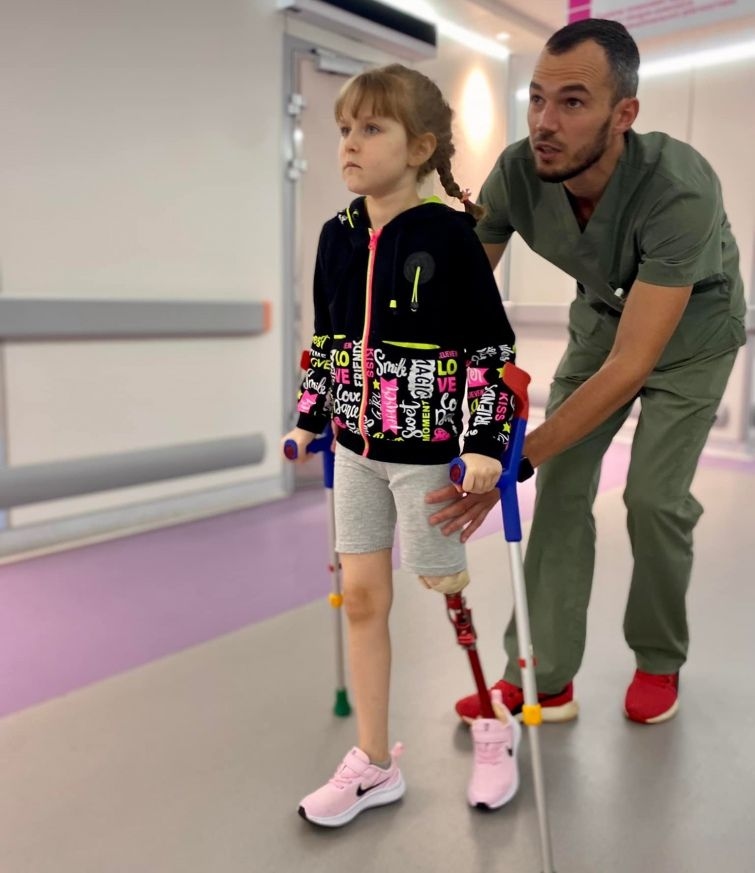
When they finally reached the Ukrainian military checkpoint, soldiers applied a tourniquet to her leg and gave her some injections: “Otherwise, she wouldn’t have made it to the hospital,” Ponomarova recalls.
Maryna and her mother, who was injured as well, spent nearly a month undergoing treatment in Kryvyi Rih, a city in Dnipropetrovsk Oblast, and were transferred to Kyiv’s Ohmatdyt hospital.
Although they had the option of getting prosthetics abroad, Maryna’s family decided to do it in Ukraine. They found a German foundation that agreed to fund prosthetics for her in Ukraine, and their challenging journey began.
“When they said they would rather stay in Ukraine (for prosthetics), I realized it was a chance for us to show that we can do it here, too,” Borozniuk says.
Many international and domestic charities offer help in funding prosthetics for wounded Ukrainian children. At the same time, the state offers to pay up to Hr 285,000 ($7,300) for lower limb and up to Hr 133,000 ($3,400) for upper limb prosthetics per child, depending on the severity of their injuries, the Social Protection Fund for People with Disabilities said in a comment to the Kyiv Independent.
Before the full-scale war, Ukrainian children needed prosthetics after losing limbs primarily because of infectious diseases, cancer, or diabetes, and on occasion due to traumatic injuries from serious accidents.
“Now, we have to deal with new traumas, like mine-explosive injuries, which differ from what we had (to deal with) before,” says Borozniuk. Psychologists also work alongside doctors to ensure children receive comprehensive care.

Nazar Bagniuk, a prosthetist at the Lviv-based Unbroken Rehabilitation Center, says there is not much difference in developing prosthetics for children and adults, adding that specialists in Ukraine are skilled enough to produce prosthetics as good as those made in Western countries.
“Unfortunately, the number of wounded and those who need prosthetics is growing in Ukraine, but not the number of prosthetists,” Bagniuk says, adding that he currently teaches new specialists at the Unbroken Center.
“The war has forced us to adapt quickly. There has been significant progress in rehabilitation and prosthetics for both adults and children. We’re not afraid. We already know what to do,” says Borozniuk.
According to him, for children, it’s crucial to start getting used to prosthetics as early as possible, as well as prepare for it “physically and psychologically.”
It took Maryna’s family some time to find a prosthetist and funding. Over this time, she got used to hopping about on one leg.
“We needed to persuade her to at least try on the prosthetic,” Borozniuk recalls.
“She started crying,” he says, adding that he suggested picking a name for her artificial leg – Kesha – and told her it was her new friend.
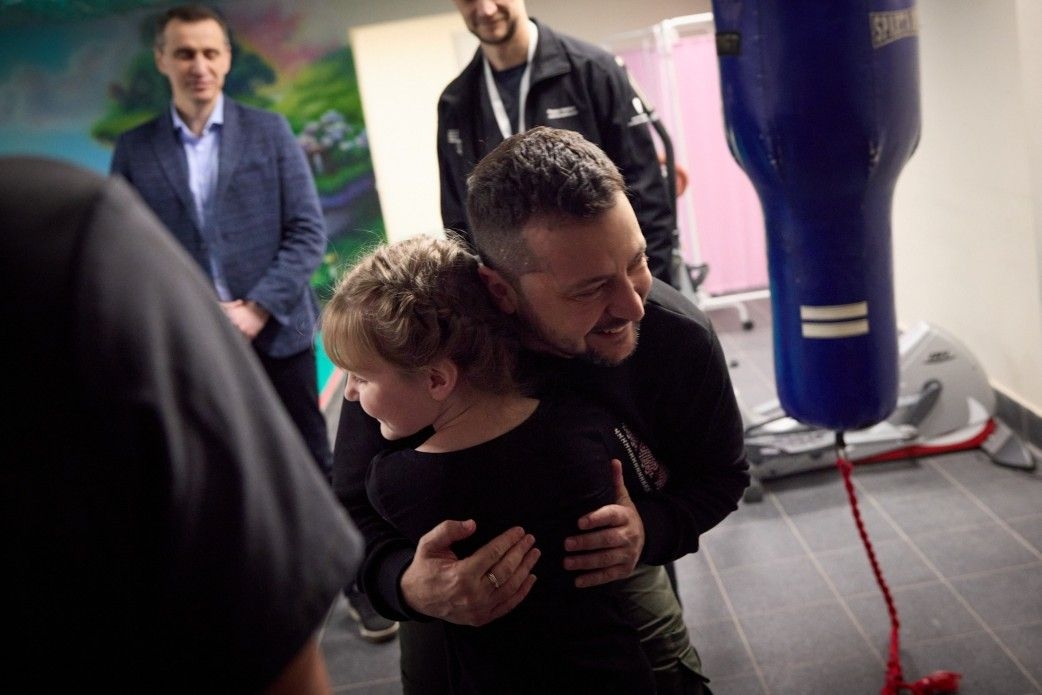
Both Maryna and her mother worked with a psychologist to help them overcome the traumatic experience. Ponomarova says it was very difficult for her to see Maryna crying and asking: “Why does everyone have two legs but me?”
When Maryna started walking with prosthetics outside the hospital, she felt insecure and embarrassed and compared herself to other children, says Borozniuk.
“When we went out to play outside, and she saw other children (without disabilities), she started crying, saying she did not want to go anywhere anymore,” he says.
“She doesn’t have any problems now and feels very confident,” says Borozniuk. “I believe it was a comprehensive effort and a credit to everyone – her parents, relatives, and doctors.”
“We, as adults, need to convey to children that it happens, and (people living with prosthetics) is normal.”
Homesick
Treatment abroad is another option. In cooperation with the European Commission, Ukraine's Health Ministry has launched a medical evacuation program (MedEvac) offering children and adults wounded by the war the necessary treatment and prosthetics abroad for free.
Yana Stepanenko, now 12, and her mother, Nataliia Stepanenko, were the first to get prosthetics in the United States.
Their family has paid a very high price in the battle for Ukraine’s freedom: Stepanenko and her two youngest children, then-10-year-old Yana and Yaroslav, were trying to escape heavy Russian attacks on their hometown of Niu York in Donetsk Oblast in April 2022 when tragedy struck.
They were at the train station in Kramatorsk when Russian troops hit it with a Tochka-U ballistic missile, killing 61 civilians and injuring 121.
“The earth began shaking, and I got knocked off my feet. I couldn’t understand what had happened when I opened my eyes,” Stepanenko recalls. “I started looking for Yana and saw that she didn’t have any shoes anymore.”
Yana lost both legs in the attack, and her mother lost one. Since Yaroslav was inside the train station he, unlike his loved ones, was unharmed.
For nearly a month, Stepanenko was separated from her children as she and Yana were treated in different hospitals, first in Kramatorsk and then in Dnipro. They reunited on the train to Lviv. Soon after, Stepanenko found out that her husband had been killed in combat.
But there was no time for them to grieve, as she and Yana were getting ready to travel overseas to get prosthetics, as their doctor suggested. They lived with a host family in San Diego, California.
In the most severe cases, Ukrainian doctors can recommend their patients go abroad for prosthetics. They contact the Health Ministry, which arranges the trip, and look for a medical facility to accept the patient, says Kacharyan. They are mostly sent to the United States, Austria, and Norway.
Getting used to walking with prosthetics took a lot of work from both Yana and her mother.

“When I took my first steps with prosthetics, it felt surreal. I could not believe I could walk again after a long time in a wheelchair,” Yana told the Kyiv Independent.
“When I first started wearing the prosthetics, they were very heavy. It was just unusual for me that I couldn't immediately run or jump on my feet like I used to,” she says.
Although they were offered to stay in the U.S., continue their rehabilitation, and get new prosthetics for Yana whenever she needed them, the family decided to return home: “We were really homesick,” Yana says.
After their return to Ukraine, Yana and her mother decided to continue rehabilitation at the Unbroken Center in Lviv. They have settled in the western city, starting their lives from scratch there.
Healing wounds
Even though Russia tried to steal their childhood, war-injured Ukrainian children with prosthetics are now learning to live their lives to the fullest.
Yana is currently preparing for the 128th Boston Marathon, which will be held on April 15. With her own example, she wants to show other children that it is still possible to have an active lifestyle, even with prosthetics.
“I want other children like me never to give up,” Yana says. “I thought I would never walk again, but people believed in me, and I started believing in myself too.”
Support from doctors eventually helped Maryna from Kharkiv Oblast recover, both mentally and physically.
“It was important to make her realize (prosthetics) were truly necessary,” Borozniuk says.
“Now she runs and jumps around, but I tell her not to do it in front of me because I get really worried,” he laughs.
After recently meeting Maryna in the Ohmatdyt hospital, little Oleksandr gained hope, and he is now looking forward to his first prosthetics.
“He now dreams of his wounds healing faster, learning to walk with prosthetics, and finally going home to see his loved ones,” says Reshetniak.
Note from the author:
Hi! Daria Shulzhenko here. I wrote this piece for you. Since the first day of Russia's all-out war, I have been working almost non-stop to tell the stories of those affected by Russia’s brutal aggression. By telling all those painful stories, we are helping to keep the world informed about the reality of Russia’s war against Ukraine. By becoming the Kyiv Independent's member, you can help us continue telling the world the truth about this war.

